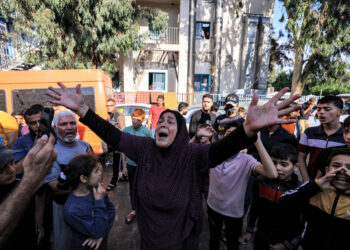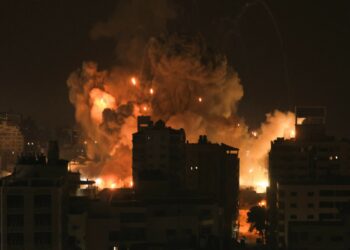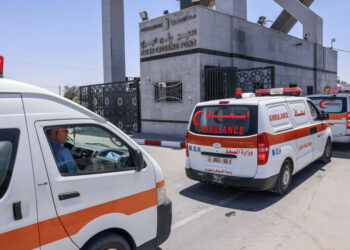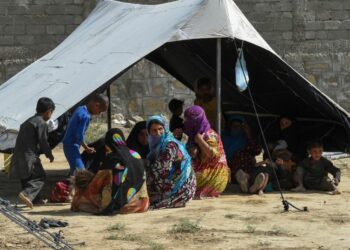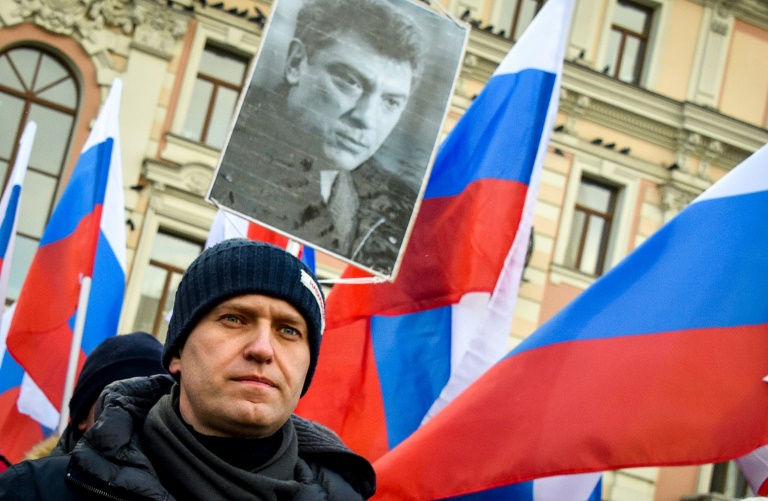Since Hamas’s victory in the 2006 Gaza elections, Israel and Egypt have enforced a blockade on the territory that has had catastrophic effects on the local economy. Gaza’s unemployment rate currently amounts to 44 percent, with more than 60 percent of people younger than 30 without a job, according to the World Bank. Furthermore, besides the hardship caused by the frequent clashes between Israel and Hamas, euphemistically called “Gaza wars,” the blockade has caused drastic shortages in goods and materials. This worsens the already precarious state of water and sanitation infrastructures and electricity supplies.
Launched on March 30 (Land Day) by Ahmed Abu Artema, a 33-year-old Palestinian independent journalist and writer, the demonstrations saw the mobilization of tens of thousands of men, women and children. Social activities and events like speeches, sports games, and concerts took place and showed a willingness to engage in a peaceful form of protest, thus breaking with the past.
However, a significant number of young men approached the border and targeted Israeli troops with stones and Molotov cocktails. By April, they launched arson balloons and kites bearing incendiary devices over the fence, causing damage mainly to Israeli properties.
Israel’s response has been overwhelming since the inception of the protests, with the Israeli military boosting its operational readiness, using tear gas and live ammunition against protesters. According to Prime Minister Benjamin Netanyahu, this has been necessary to defend Israel’s borders and prevent what he termed as “mass infiltration and terrorist attacks.”
Escalation of Violence
Violence escalated dramatically on May 14 and thereafter, as a result of the ceremonial inauguration of the U.S. embassy in Jerusalem and the intensification of Palestinian protests. While U.S. President Donald J. Trump depicted the move as “a great day for Israel,” the day will be remembered as the bloodiest since 2014. In total, 58 protesters were killed and 2,700 were injured by live ammunition and tear gas, according to the Palestinian Health Ministry. In the following weeks, Palestinian militants and civilians’ alike launched rocket and mortar fire, while the Israeli military responded with its air force striking Hamas positions in Gaza.
With more than 14,000 wounded and 132 dead, the caseload from seven weeks of protests has surpassed that of the 2014 war. This caused the unanimous disdain of human rights organizations and, primarily, the United Nations, which pointed out the disproportionate reaction of Israel. On May 15 Michael Lynk, the U.N. Special Rapporteur on the situation of human rights in the Palestinian territories occupied since 1967, condemned Israel’s excessive response towards primarily unarmed demonstrators at the border.
A month later, the U.N. General Assembly condemned Israel for extreme use of force against Palestinian civilians and asked U.N. Secretary-General Antonio Guterres, who was reportedly “shocked” by the use of live ammunition against civilians, to recommend an “international protection mechanism” for the Palestinians in the occupied territories. Although Guterres and the U.N. General Assembly denounced Hamas’ actions and its consequences on Palestinian and Israeli lives, the use of excessive force by the Israeli military has taken center-stage both in the U.N. system and in the public debate.
But the Gaza events are alarming, not just because of the excessive and disproportionate force used by Israel and the sheer size of casualties and human suffering it has caused. The political and social trends of the violence reveal additional concerns about Israel’s domestic politics, the international conjuncture and the situation of the Palestinians in Gaza, Israel, and the West Bank.
The current political constellation of the Israeli political elite is profoundly skeptical if not inimical to any attempt to negotiate with the Palestinians as partners. Palestinians are overwhelmingly represented and confronted as a security threat or as a nuisance that derails more important projects.
Considerable Pressure
Jerusalem’s Arab population has been under considerable pressure through encroachments on their property, property development rights, access to facilities, and symbolic warfare that aims at undermining their historical connections to the city.
West Bank Palestinians experience similar challenges including a systematic settlement building and expansion program and the institutionalized geographical fragmentation of the territories they lay claim to. But it is the Palestinians of Gaza that have, since the withdrawal of the Israeli forces from the strip, experienced unparalleled challenges.
The Palestinians in the overpopulated strip, often and justifiably described as “the world’s largest open-air prison,” have been suffocated under a crippling blockade. Israel claims the blockade is intended to ensure Hamas is militarily neutralized and agrees on a modus vivendi, but degrades and denies vital resources and services to the population in this process. The Gazans already endured several devastating wars where the Israeli Defense Force used disproportionate and near indiscriminate force.
Conservative Israeli elites see the perpetuation of an impoverished Gazan population ruled by a government with hostile rhetoric towards Israel as a convenient way of showcasing the “threatening,” “backward,” and “inferior” faces of the Palestinian “other” to their domestic and international audiences. It makes it easier for the Israeli elites to bring home the message that dialogue and mutual understanding is not possible.
Gaza’s Palestinian population, on the other hand, is facing unbearable conditions, some of which are outlined above. They live incarcerated in a resource-starved area, with a fragile economy. The majority of the Gazans is largely dependent on some form of financial assistance. The population faces disproportionate health and rehabilitation challenges but has shown resilience and, as the recent “March of Return” cultural events have demonstrated, the capacity to engage in peaceful and creative action.
Despite the significant support Hamas has been enjoying in the strip, the organization has not been immune to criticism and the demand to end Gaza’s isolation and impoverishment. The ideological and organizational changes of 2017, involving the election of a new Hamas leadership, the introduction of hints of compromise into the organization’s charter, and a greater readiness to engage in reconciliation with the Palestinian Authority, Israel and even Saudi Arabia indicate that Hamas’s role has been complex and nuanced. This contradicts standard U.S. and Israeli discourse. It has indeed reflected this craving for normality among the population without however avoiding oscillation between the internal push for renewal, the organization’s foundational narrative of resistance, and its governance tasks, which frequently meant imposing unpalatable means of control of the population.
Legitimizing Gaza’s Isolation
However, through ostracizing Hamas in the international context (the organization is considered to be a terrorist group by many countries, including Israel, Saudi Arabia, and the U.S.), the isolation of Gaza has been perpetuated and legitimized.
In this particular context, the recent U.S. policy reorientation presided by President Trump is extremely pertinent. Underpinned by a lack of tolerance towards the “perceived” unwillingness of the Palestinians to negotiate with the hawkish Israeli government and its equally hawkish predecessors, the U.S. administration has more openly supported current Israeli positions. It chose to ignore the suffering of the population of Gaza and to turn a blind eye to the recent violent and lethal response to the events near the Gaza border. It decided to initiate withdrawal of funding for the U.N. Relief and Works Agency for Palestine Refugees in the Near East, which is crucial for the viability of Gaza’s economy. It chose to legitimize settlement building in the West Bank and the periphery of Jerusalem and recognized the latter as the capital of Israel by moving the U.S. embassy to the city.
As we have argued elsewhere, the U.S. policy shift served to embolden those who advocate a more aggressive territorial policy and the continuation of the erosion of the possibility of an independent Palestinian state. Following this line has been, in the case of Gaza, interpreted as license for a disproportionate and lethal response to civilian protest and low-level militant activity.
Dehumanization of Palestinians
One of the most alarming developments that the current events at the Israeli border reveal is the degree of the institutional and cultural dehumanization of Palestinians inside and outside the country.
A short video from the events shows the blurry image of an unarmed Palestinian approaching the border fence, only to be shot by an Israeli soldier. The scene was shrugged off by Defence Minister Avigdor Lieberman, who said that the sniper should get a citation, but the soldier who filmed him should be demoted, even with both the soldiers using expressions of racial abuse against their targets.
This response reveals a dangerous transformation of the already polarised Israeli political discourse into one uncompromisingly distinguishing between friend and foe, conflating dissent with collusion with the unpalatable Palestinian “terrorists.” Israeli politicians increasingly talk about Palestinians in disparaging ways without any restraint or inhibition. These politicians include the prime minister, an array of ministers like Minister of Education Naftali Bennett and Minister of Justice Ayelet Shaked, Knesset members, and local councilors.
They have often called for collective or family punishment of Palestinians for particular acts of violence and justified discriminatory practices and the use of force against them. Indeed, during the recent events at the Israeli border, spokesman for the governing Likud party Eli Hazan referred to the 30,000 civilian protesters as “legitimate targets.” This is a worrying trend that is not restricted to Israel’s political class but has become widespread among the broader public.
This dehumanization of the suffering population of Gaza is by no means new. The first alarming signs were seen during the 2014 Gaza bombing when Israeli residents of border towns such as Sderot gathered on the hillsides to watch the “spectacle” of the bombardment of the strip. Israelis have become accustomed to seeing Gaza as a breeding ground for terrorists, and, conversely believe that its residents deserve no rights, empathy or solidarity. Increasingly narrow-minded media who often cultivate denial and justify repression helped to shape this narrative.
Given the current international and domestic conditions, this ongoing desensitization of the Israeli public makes the future look bleak. Unfortunately, the scandal-plagued Israeli leadership sees the opportunity to render a future reasonably equitable and fair agreement with the Palestinians untenable in the current conjuncture.
Gaza is a key element of a strategy to subjugate and demoralize Palestinian society and to convince the international community of the futility of a future settlement. Because the Israeli government lacks vision, or even some sort of practical blueprint for the future and dearth of a challenge to its hegemony, Netanyahu’s administration is likely to be trapped in a vicious circle of dehumanizing the population of Gaza and degrading the infrastructure the latter relies on to justify precisely its poverty of imagining a better future for both Israelis and Palestinians.
Disclaimer: The views and opinions expressed here are those of the author and do not necessarily reflect the editorial position of The Globe Post.


